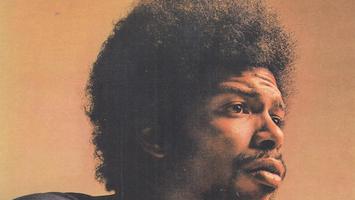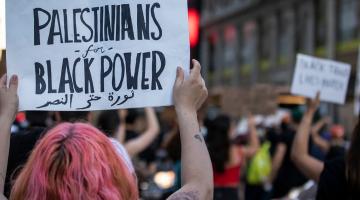“While we may dismiss the concept of a Negro problem as a valuable dividend-paying fiction, it is clear that the Caucasian problem is painfully real and practically universal.”
Before he became a reactionary, George S. Schuyler — the infamous Negro contrarian, curmudgeon, and conservative — was a radical. Schuyler is perhaps best known for Black No More, his sci-fi send up of high society Harlem’s racial predilections that turns on a chemical discovery that can turn a Black person white. Scathing in its critique, Black No More is hysterically funny in its content. But Schuyler could also be deadly serious. Especially when it came to white racism.
Take, for instance, Schuyler’s contribution to What the Negro Wants, the collection of essays edited by the great historian and Howard University professor Rayford W. Logan, published in 1944. Amidst contributions from W.E.B. Du Bois, A. Philiph Randolph, and Doxey A. Wilkerson — towering figures of the Black left in the 1940s — Schuyler’s essay is the most radical. His essay turns the editorial impetus of the collection on its head. He rejects the analytical and political assumptions behind What the Negro Wants — and the idea that there is a “Negro Problem” generating the social and political friction in the United States. For Schulyer, what the negro wants is not the issue and the “Negro Problem” does not in fact exist. The problem, he argues, is white people and their longstanding, rapacious demands of the earth and its inhabitants.
Schuyler’s essay is titled “The Caucasian Problem” and it is an astonishing account of the viciousness of white geographic expansion and wholesale terror over five centuries. What is clear after reading Schuyler’s essay today, is that this Caucasian problem is as much an issue now as it was in 1944 and in the 1500s.
We reprint George S. Schuyler’s “The Caucasian Problem” below.
The Caucasian Problem
George S. Schuyler
By a peculiar logical inversion the Anglo-Saxon ruling class, its imitators, accomplices and victims have come to believe in a Negro problem. With great zeal and industry those controlling the media of information and instruction have succeeded in indoctrinating the whole world with this fiction. It is written into the laws, accepted by organized religion; it permeates our literature, distorts our thinking and is deeply imbedded in our customs and institutions. So successful has been this propaganda that even its unfortunate victims often speak of it with the same conviction with which many people talk of guardian angels, ghosts and malignant spirits. It is the "stop thief" technique at its best–a great testimonial to the ingenuity of exploiters with a bad conscience; for while there is actually no Negro problem, there is definitely a Caucasian problem.
Continual reference to a Negro problem assumes that some profound difficulty has been or is being created for the human race by the so-called Negroes. This is typical ruling class arrogance, and, like most of the faiths circulating in our civilization, has no basis in fact. It has been centuries since any Negro nation has menaced the rest of humanity. The last of the Moors withdrew from Europe in 1492. Since that time not one of the numerous industrially retarded but socially complex African states has molested the rest of the world with the possible exception of pirates of the Barbary Coast. They have neither possessed the means nor the inclination to do so, and they lived more or less happily in isolation until the coming of the European with his Bibles and bullets.
The so-called Negroes did not inaugurate the trans-Atlantic slave traffic, although some profited from it. They have not invaded anybody's territory for almost a millennium. They have passed few if any Jim Crow laws, established no Jim Crow customs, set up few white ghettos, carried on no discriminatory practices against whites and have not devoted centuries to propaganda attempting to prove the superiority of blacks over whites. The last Negro writing with that slant was in the Tenth Century. We seek in vain during modern times for any record of Negroes having destroyed any white cultures, having ravished and debauched white women wholesale, or having stolen white manhood. On the other hand the history of the world since 1815 is crowded with references to wars, campaigns and expeditions by Caucasian Powers against almost every African and Asiatic nation.
Of the international capitalists who control the lives of over a billion colored people practically all are white, and so, also, are the technicians, brokers, lawyers, generals, admirals, artists and writers who serve them. Colored people are largely excluded from this select group and relegated to the economic fringes of society where labor is long and hard and pay is short and seldom. The occasional exception here and there only emphasizes the point. The only sense in which there is or has been a Negro problem is in the colored folk's natural human aversion and opposition to conquest, enslavement, exploitation and debasement during the long and bloody period of Caucasian military ascendency.
With the exception of such camouflaged colonies as Haiti, Ethiopia, Liberia and Egypt, all the Negro countries have been overrun long since, their rulers killed or exiled and their peoples chained and exploited like those of the European lands currently under Nazi rule. The colored countries in Latin America and Asia are either directly the victims of aggression and occupation by Caucasian powers–chiefly Anglo-Saxon and their imperialist satellites–or they are controlled indirectly by native dictatorships backed by white international bankers and their tax-supported armed services. Where and when the opportunity presented itself, the other Caucasian countries did likewise or to the extent of their abilities. Thus, Russia subjugated the people of Siberia, Spain slaughtered her way to empire in the Americas and the Philippines, Germany and Italy grabbed remnants in Africa and Asia, and Denmark gathered a few islands in the Caribbean. Portugal, Holland and Belgium have assembled valuable real estate and subject peoples in Asia and Africa, although the Japanese have rudely relieved these British satellites of some of their ill-gotten gains.
The only nation that has become a problem to the Caucasians is Japan which was the hired gunman of Anglo-Saxondom until the beginning of this decade, checkmating Russia and helping to weaken, undermine and debauch China. Only when the Nipponese bandit went into business for himself and practised what he had been taught, equipped and financed to do by erstwhile employers, did he become a problem.
While we may dismiss the concept of a Negro problem as a valuable dividend-paying fiction, it is clear that the Caucasian problem is painfully real and practically universal. Stated briefly, the problem confronting the colored peoples of the world is how to live in freedom, peace and security without being invaded, subjugated, expropriated, exploited, persecuted and humiliated by Caucasians justifying their actions by the myth of white racial superiority. Put bluntly, that is the concern uppermost in the minds of all intelligent and sensitive colored people whether they live in Birmingham, Boma or Benares. They are nauseated by the fictions and hypocrisy cloaking military aggression and crass materialism, and everywhere today their dream is to rid themselves of the whole Caucasian problem which is basically the same throughout the colored world.
Whether he be as wise as Einstein or as saintly as Jesus, the colored man must everywhere accept a subordinate position. There are restrictions on where he may live, on what work he may do, with whom he may associate, how and where he may travel, on his right to choose his rulers, on his education, on whom he may marry, and, in many places, on where his last remains may be interred. The problem is worse in Kenya or Australia than in Mississippi or Sierra Leone, but the general pattern is similar. It is no easier for him to get bed and board in London than it is in Washington, D. C. Whether in the Transvaal or in Texas, he is at the bottom of the industrial hierarchy–except in war time when the system is imperilled and every man is expected to do his bit for democracy. He observes that the press, radio and cinema are primarily for the entertainment and benefit of white people and almost never for colored people. He has become painfully aware that generally throughout the world he is treated by white people as a pariah. Whether in Fiji or Florida, the black man's burden is this vicious color caste system which makes his world a cultured hell. On the other hand, the white man's burden is his guilty conscience which he sublimates with racial fictions to which he laboriously accommodates his morals and ethics.
The term Negro itself is as fictitious as the theory of white racial superiority on which Anglo-Saxon civilization is based, but it is nevertheless one of the most effective smear devices developed since the Crusades. It totally disregards national, linguistic, cultural and physical differences between those unable to boast a porcine skin, and ignores the findings of advanced sociologists and ethnologists. Avoiding the consideration of such obvious differences between colored people, it facilitates acceptance of the fiction of similarity and identity which is easily translated into a policy of treating all colored people everywhere the same way.
The once-popular American ditty, "All Coons Look Alike," was a musical statement of the Anglo-American color philosophy already embodied in the law and hallowed by custom and tradition. So likewise was the thought expressed in that other popular American song of the turn of the century, "I'd Rather Be a White Man Than a Coon, Coon, Coon." In the word "nigger" (the overall-and-jumper version of "Negro") we have a term conveying this thought throughout the Caucasian-and especially the Anglo-Saxon-world. To a lesser extent it circulates also among the satellite Belgian, Dutch and French ruling classes, and among the other white aristocracies. Almost everywhere the colored people are "niggers" or they are called by the less biting synonyms: "native," "kaffir," "fellah," "boy" or "coolie," which serve the same purpose. In the United States the childish device of attempting to make "Negro" respectable by using a capital "N" seems to have deceived everyone except a realistic, and therefore insignificant, minority of thinkers.
Of course "white" and "Caucasian" are equally barren of scientific meaning but are similarly useful for propaganda pur- poses. There are actually no white people except albinos who are a very pale pink in color. A white skin would be a diseased or dead skin. If the name "Caucasian" is meant to imply racial purity or unusual paleness, it is certainly fallacious because the original home of the Caucasians, from which some romantic scientist assumed the present Europeans migrated, contains some 150 to 300 different "races" or types, and, as Ruth Benedict points out: "Caucasians have no characteristic cephalic index or body height, no specific hair color or eye color; their noses may be Roman or concave; even the color of their skin is extremely variable." Aryan, of course, is a language designation, and anybody using an Inda-Iranian tongue is an Aryan regardless of appearance; while Nordic, as a description of the Northern European blondes presumed to be a pure race is somewhat invalidated by the belief of some anthropologists that they are bleached Bantu who originally came north out of Africa and followed the receding glaciers.
However, the point is that these general terms "Negro" and "Caucasian," "black" and "white" are convenient propaganda devices to emphasize the great gulf which we are taught to believe exists between these groups of people. It is significant that these divisions very conveniently follow the line of colonial subjugation and exploitation, with the Asiatics and Africans lumped together smugly as "backward peoples," "savages," "barbarians" or "primitives": i.e., fair prey for fleecing and enslavement under the camouflage of "civilization."
Prior to the rise of the present imperialist Powers on the wings of piracy and conquest, and during the period when the African states were still intact and powerful,colored people were generally known as Saracens, Moors, Ethiopians, Africans or by other nationalistic names which conjured visions of pomp, tradition, glory and might, or they referred to some specific locality. Before the inauguration of the slave traffic, Europe knew these people as warriors, merchants, physicians, sailors and artists; but afterward they ceased being Mandingoes, Yorubas, Fulanis or Vais and, merged in common servitude, they became "niggers," or the more dignified "Negroes." These terms became in time synonymous with servitude and debasement, and still are.
The slave was a piece of property, a thing. Learned clerks argued long and heatedly over whether or not he was a human being and possessed a soul. The term Negro or "nigger" implies that he is still a thing, a member of a robot-like mass of inherently inferior beings essentially the same regardless of intelligence, education, skill, profession or locality, and in any case of lower status than any white person though the latter be a criminal or imbecile. Thus the so-called Negro race is a melange representing every known variety of human being with nothing whatever in common except a common bondage and a common resentment against enforced poverty and pariahdom, and an increasing de- termination to rid the world of the Caucasian problem which hampers its progress and development.
The racial fiction has been industriously spread over the world with the extension of white hegemony. The Anglo-American immigration policies excluding Orientals from the United States, Canada and Australia, have been part of the white supremacy doctrine introduced to Asiatics. It is noteworthy that while these colored peoples are excluded from white lands, the Caucasian missionaries,soldiers,sailors,racketeers, merchants, salesmenand investors have swarmed over the South Seas and Asia carrying the torch of civilization which, as René Maran has well said, "consumes everything it touches.
Wherever they landed, they insisted upon and got special privileges, thanks to superior arms. Soon there were special Caucasian concessions, courts, and "spheres of influence" throughout Japan and China backed by ubiquitous detachments of troops and occasional cruisers. India fell to the British adventurers. The former Chinese imperial provinces of Thibet, Manchuria, Burma, Malaya, Cochin-China, Annam, Cambodia, Tonkin and Laos got white overlords. The erstwhile independent kingdoms of the East Indies languished under the heels of Dutch freebooters whose regime became so cruel and corrupt that it shocked Sir Stamford Raffies, founder of Singapore, when he took over as governor during a temporary transfer to the Union Jack in 18u. The numerous paradises of the Pacific, those lovely, languorous emeralds set in the azure seas,became sugar and pineapple plantations or mining concessions of absentee owners and worked by peons.
The white man became the sahib, tuan or master, living aloof in luxury with the prettiest "native" women (whom he abandoned when he returned home). The "native" saw his land taken, his crops appropriated, his labor stolen, his leaders debauched or imprisoned, his culture undermined and destroyed, his family and friends debased by alcohol and opium, and their lives shortened by malnutrition and disease. Along with this imperialism went various forms of Jim Crowism and humiliation. It is not singular that these Asiatic colored folk are in revolt against white rule. To them the Caucasian problem means the same thing that it does to the serfs of Georgia, of Trinidad and of South Africa.
Turning to Latin America we see basically the same problem. There is to be found the same white economic and financial ownership and control of natural resources and public utilities administered by white or mestizo politicians financed and main- tained by foreign loans and subsidies. As an inevitable corollary we find the Indio-African masses impoverished and degraded, with the little islands of whites living in affluence and looking down upon them as "spigs." [i.e., “spic”] Significantly enough the more highly colored Latin American countries are regarded as having failed to live up to the democratic ideal whereas the "white" lands like Argentina, Chile and Costa Rica-equally torn at intervals by internal revolts and bossed by alien-supported dictators-are hailed as successes. A more sinister aspect of this economic domination is the spread among the white and near-white Quislings of the Nordic-superiority nonsense prevalent elsewhere. Both Waldo Frank and Donald Pierson have recently noticed this development in Brazil, although so far it is happily restricted to only a few.
It is noteworthy that most Latin American nations are careful to send only white or near-white diplomatic and consular representatives to England and the United States. The experience of Haiti on this point is very illuminating. From 1804 to June 5, 1862, the United States refused to recognize Haiti although there were American legations in twenty-one countries of less commercial importance to America, and although many other nations, including Great Britain, had done so. The reason was clear. Senator Thomas Hart Benton of Missouri very succinctly stated the case for the opponents of recognition:
Our policy towards ... Hayti has been fixed ... for three and thirty years. We trade with her, but no diplomatic relations have been established between us.... We receive no mulatto consuls, or black ambassadors from her. And why? Because the peace of eleven states will not permit the fruits of a successful negro insurrection to be exhibited among them. It will not permit black ambassadors and consuls to ... give their fellow blacks in the United States proof in hand of the honors that await them for a like successful effort on their part. It will not permit the fact to be seen, and told, that for the murder of their masters and mistresses, they are to find friends among the white people of these United States.
President John Quincy Adams quickly concurred in this view. Later in 1852 when a system of "partial recognition" was prepared, the Emperor Soulouque upset the apple cart by appointing an American to be a Haitian consul at Boston. Secretary of State Daniel Webster refused to accept an appointee bearing that title, implying recognition, but stated that any person "not of African extraction" would be welcomed as a commercial agent. Even when the Haitians promised to send a diplomatic representative to Washington so light that he would be indistinguishable from the other members of the diplomatic corps, the United States was adamant–until the slaveholding South seceded and thus lost its grip on American foreign policy. The lesson has not been lost on other countries.
In the Caribbean area where American "penetration" is most marked the color line has kept pace with Yankee imperialism. Cuba, Panama and Puerto Rico have become well acquainted with this phase of the Caucasian problem. Since the taking over of naval and air bases in the British West Indies, American mis- sionaries of Negrophobia have alarmed the "natives" by insistence upon Jim Crow set-ups and practices formerly unknown even in those English colonies.
Only when we understand the universal character and international ramifications of this Caucasian problem are we able to see how faithfully it follows the pattern in the United States, with important differences and variations. Here the so-called Negroes are a small minority living in the midst of a great majority. They use the same language and have the identical culture. They arrived with the whites-and before most of them. Both peoples have made important contributions to the development of this civilization which both regard as their own. The colored Americans are perhaps more American than most of the whites since they have practically no foreign connections. The ruling class here encourages the white generality to believe they control the government, but it does not permit the colored minority to share this illusion. The thousand and one devices and artifices used to prevent the colored people's full enjoyment of citizenship rights and privileges fully attest to that.
The position of the colored subject in England, although born to the soil, is equally unenviable, and in some ways is worse. Neither ruling class, unlike the rest of the Europeans, is willing to accept the colored person for what he may be as an individual, perhaps because such exceptions are regarded as undermining the color caste system. There are exceptions but their paucity only emphasizes the rule. Maintaining this international bi-racialism in the face of the growing demand of colored people everywhere for justice, equality and opportunity is what white spokesmen mean by "the Negro problem." It is the same problem which confronted the French in Indo-China and Africa, the Dutch in the East and West Indies, and the British in Burma, Malaya, India, Africa and the Caribbean.
Students of the Caucasian problem will admit that Negrophobia has spread far beyond the upper and middle classes and has penetrated the lowest stratum of white society. But they are aware that the ruling class and its intellectual gendarmerie set the fashion in prejudices as they do in clothing, habitations and hairdo. The uncannily accurate polls of public opinion have proved that these few shape the thought of the masses, rather than the other way around. There is much evidence that the color prejudice of the masses is not too deeply rooted. For one thing there has always been a natural trend toward fraternization between the common folk, regardless of skin color, as shown by the strenuous efforts throughout American history to prevent it and by the progressive lightening of the color of American Negroes.
It is clear that the numerous laws and regulations enacted to halt association between the colored and white people on a plane of equality have been written and passed by the few and not by the many. It was the "pillars of society" who insisted upon racial segregation. JimCrow schools, railroad coaches, bus compartments and waiting rooms would not exist if those who are influential in American society had opposed them. They have not frowned upon the self-appointed missionaries of racial purity. Wherever permitted, the common people have established the democratic relations that should exist in a free country.
Even after three centuries of Negrophobic indoctrination, no deep-seated revulsion or antagonism has prevented 15,ooo interracial marriages and countless clandestine relations in all parts of the country. It would be extremely difficult to find a community in the United States where members of the two groups reside and where no intimate interracial relationship between both sexes of both "races" exists. It is well known that white people from the most Negrophobic areas will move to other and more liberal communities and speedily adjust themselves to eating with, riding alongside, working and living with colored people with extremely little friction and scarcely a murmur of protest. The growth of Negro ghettos in large cities can be traced chiefly to avaricious realtors eager to roll up bigger profits through artificial scarcity of habitations. The fact that almost every one of these ghettos has been permitted to expand with increased Negro migration indicates that profits rather than principles were be- hind the original restrictions.
The United States government has bowed without exception to the will of the ruling class in these matters. No one seriously contends that it is a government of the people. Although colored and white soldiers served side by side in the early wars of the Colonies and the Republic, the federal government segregated them in separate units during and after the Civil War. Following the First World War it restricted colored sailors to service only in the mess departments of its warships. It is not hard to guess why Negroes have had such difficulty in gaining admission to the military and naval academies, or to the citizens' training camps. It is no accident that at least nine-tenths of the colored soldiers and even a large percentage of colored sailors serve as stevedores, laborers and in other "service" branches. It has remained for the French General Henri Giraud to state bluntly the reason for this policy in the case of the Jews. The same reasoning is doubt- less behind the American and British restrictions, but inherent hypocrisy militates against such frank statement. Ordered General Giraud: "Jewish commissioned and non-commissioned officers and men in the reserve will generally be assigned to special non-combatant and work units. This measure appears necessary in order to avoid having the entire Jewish population gain the title of war veteran, which might prejudice the status given these people after the war."
The Panama Canal Zone, built largely with Negro labor and run autocratically by the War Department, is a strictly Jim-Crow set-up operating under "silver" and "gold" euphemisms, with the whites naturally coming under the name of the more valuable metal. In practice this means the operation of two sets of public places, separate housing and a double standard of pay and promotion. The American people did not insist that this be done. Nor did they demand that the War Department divide the Puerto Rican National Guard regiment so that light islanders served in one branch and dark folk in the other, with the result that brother was often separated from brother.
Segregation and discrimination have been systematically practised in the United States Civil Service, and although identifying photographs on applications (as Negro traps) are no longer required, it just happens that colored workers seldom seem to occupy certain positions, especially those of the white collar variety where they might have to meet the general public. The student of these tortuous artifices must ever wonder how much time and effort is spent by tax-paid officials on working out these schemes devised to prevent just treatment of fellow citizens. The same meticulous care in protecting white supremacy is to be observed in all other departments of the government, and this is not done at the insistence of the white masses. It is also significant that such public positions as Negroes held fifty years ago are in many instances unobtainable today.
The United States Supreme Court is certainly far removed from the pressure of the masses of white Americans, and yet it has distorted and twisted out of all semblance to the originals those Constitutional amendments guaranteeing full rights of citizenship to all citizens regardless of creed or color. By its interpretations of the Constitution, colored citizens have been systematically reduced to the status of half-men. It has consistently supported segregation as a genuflection to State's Rights while denouncing discrimination–knowing full well that the two are inseparable when applied to a weak minority. No mob has as yet stood at the doors of the Justices' chambers compelling them to concoct unjust decisions blessing the anti-intermarriage laws of two-thirds of the states which Hitler so slavishly copied. They did these things in obedience to the Negrophobic philosophy of our dominant class.
Congress, which has always faithfully represented the American propertied interests, administers the District of Columbia. In this, the capital of the world's allegedly greatest democracy, a colored citizen is and always has been a pariah. No mass upheaval has prevented the District Committee from ending this shameful situation, and thus making it possible for Negroes to be free in at least one place in the Republic. The District could certainly have as liberal civil rights laws as New York, Illinois, Connecticut and New Jersey where the masses of white people actually vote and, in the main, are no more liberal and tolerant than the inhabitants of the nation's capital, who do not vote and thus exercise no control over their civic administration.
The students of the Caucasian problem do not find it surprising that those who control the government are no more liberal than those who operate it. This small minority of financiers, industrialists and merchants has made perhaps the greatest contribution to the problem by barring Negroes from the mechanical trades and technical professions, from commerce and finance. This "cold pogrom" has caused more bitterness among colored people than any other American racial policy. It is not a policy which can be blamed on organized white labor, as American business is wont to do, because only a few industries and businesses, up until a decade ago, were organized by the unions. The rest were open shop, free to hire and fire whom they chose without inter- ference. Invariably they chose the racially chauvinistic course, and then declared it was done because their unorganized hands objected to working alongside Negroes. The successful interracial employment policy of Henry Ford, the greatest industrialist, gave the lie to these excuses.
Unquestionably a score or more of unions of skilled workers have made the Caucasian problem more difficult by adopting constitutional or ritualistic provisions barring colored workers from membership, and thus from earning a living. But here they have been upheld and encouraged by the courts of justice (?) and by the overwhelming majority of the employers. If there had been any solid front of business and financial interests against color discrimination in industry, it would have never found a foothold. The fact that under wartime stress thousands of employers have lowered the color bar with little protest and no decrease in production shows that it could have been done years ago.
While numerous labor unions have been and are guilty of color discrimination, and have contributed much to keeping the colored people hanging on the economic fringes of society, it is seldom recognized that organized labor as a whole has been more liberal than organized business, organized religion or organized education. If there are a score of labor unions from which Negroes are barred there are thousands of churches and schools which do not accept them, and an equal number of busi- ness and professional organizations where, to say the least, colored members are not welcome.
However, there can be no question about the increasing public aversion of the white masses to Negro equality. Fundamentally, racial relations have worsened as the propaganda of white supremacy has sunk deeper and deeper; and the Aryan policies of government, the courts and business have become more widespread while national leaders denounced Hitler, Goebbels and Rosenberg. Bi-racialism has become the accepted practice in America as in South Africa at the time when the shouts are loudest in praise of freedom and democracy. In most instances this has meant the exclusion of Negroes, legally and in practice, because even the United States is not rich enough to maintain two sets of facilities of equal quality and quantity, even if the desire were there.
Thus, on a little higher scale, America is following the African and Asiatic practice. The basic philosophy of the white rulers here is the same as that elsewhere. It is not a national problem but a world problem. But curiously enough, as the Caucasian problem has grown worse, there has been an increasing denial of the white supremacy philosophy and of the whole racial mysticism by more and more authorities on the subject. Not only is the superiority of one race being vigorously denied but the whole concept of race is being effectively challenged. This phenomenon dates chiefly from the First World War. Numerous books and articles disproving the racial basis of supremacy have been writ- ten and circulated. Anti-discrimination clauses in state and federal laws and regulations have increased yearly. Even some of the sternest Negrophobes deny that they are prejudiced against colored people and state their opposition to color discrimination. A few school and college textbooks have been written and adopted which attempt a rational approach. It is becoming infrequent for newspapers to wave the red shirt of racial antago-nism as was the wont of so many in the not-so-distant past. All of the leading magazines are "right" on the race question–or at least they do not now flaunt their phobia. All unions of the Congress of Industrial Organizations have anti-discrimination clauses in their constitutions. Several A.F. of L. unions have become more liberal on the question. Official pronouncements of the various Christian church groups begin to breathe the spirit of Jesus on the matter of color-although practice falls far, far short of the ideal. Three times in the past twenty years the House of Representatives has passed anti-lynching bills and it recently voted against the poll tax. Interracial committees have grown and flourished all over the country. It has become not uncommon to see news items in Southern papers about Negroes who have not committed rape, robbery or arson.
But unhappily this dramatically sudden change has come too late. The die has been cast. The snowball has reached such proportions and velocity that only some determined and revolutionary program can stop it. A small but growing number of white people in the United States and elsewhere realize that this is a Caucasian rather than a Negro problem and have been trying to do something about it. But the process of indoctrination has gone much too far for all the ordinary remedies. A few books, articles and pamphlets, a few polite committees, occasional radio speeches and sonorous pronouncements from politicians-these will not suffice to recondition the public mind. We cannot teach racial fictions from 1619 to 1919, and then expect people to change overnight to brotherly love and neighborly justice.
In the early days there was fraternization, intermixture and intermarriage between the masses of Negroes, whites and Indians in all the colonies. Had this process been permitted to continue publicly and unhampered, there would now be no Caucasian problem. But those in authority insisted on all sorts of legal and extra-legal devices to enforce bi-racialism. Through the years it became a social distinction and an economic advantage to be non-colored. Despite this advantage of being white, the masses gradually lost their freedom and their hopes in a progressively regimented machine of feudalism draped in the habiliments of democracy. As they sank lower and lower into a proletarian status, they clung the more desperately to the one possession that could not be taken from them-their superior status as whites. This lifted them a notch higher than somebody else; and to a drowning man, an inch is as good as a mile. By virtue of their absence of color, they can go wherever they please-if they have the money; marry whom they wish–if· they have the money; live where they choose–if they have the money. The problem, of course, is to get the money. Nevertheless it is comforting to know that nature has put Utopia within reach.
Having become used to this situation by long conditioning, the people are more reluctant to change their habits, even if it can be demonstrated beyond doubt that those habits are wrong. People are not motivated by what is right but by what they believe to be right-and the general white public believes that discrimination and bi-racialism are right because they have always been told so. So the white supremacy propaganda has become a Frankenstein's monster which, having largely served its purpose, the more intelligent members of the ruling class would fain destroy but now are terrorized by their creation. Of course it must be admitted that they are not as eager for change as they were when the Afrika Korps was pounding toward Alexandria, when the panzers were on the outskirts of Moscow and half our Pacific fleet lay on the bottom of Pearl Harbor.
On the other hand, while a few whites have realized that the so-called Negro problem is actually a Caucasian problem, millions of colored people have arrived at the same conclusion. For some years after emancipation there was a general belief among American colored people that they were responsible for their lowly status, and that all they had to do was to measure up to the requirements of Anglo-Saxon society and they would be accepted as individuals on their merits. Similar views were held by bright and ambitious colored folk in other parts of the world before they discovered the difference between Caucasian professions and practices. To be sure there was a skeptical minority which had so little faith in the big white brother that it urged emigration. But these fellows were shouted down by the chorus of optimists.
However, as Negro literacy increased, and the true nature of the problem was brought home by reading, travel and experience, disillusionment and pessimism took possession.This great awakening came shortly after the realization that the war for democracy had been a war for white democracy–and little of that. When the deluge of propaganda died down, they discovered that they had been carried "back to normalcy." This increasing disillusionment has driven the Negroes within themselves, bringing about a group solidarity as basically unhealthy as that of the whites, but just as real. It has developed a racial chauvinism countering that of the whites which has dangerously deepened the gulf between the two peoples who are actually one people. The study of African history and civilization, the fostering of Negro business, the support and growth of the Negro press, the power of the Negro church, and the general development of anti-white think- ing is a reaction to social ostracism and economic discrimination. Race, which began as an anthropological fiction, has become a sociological fact. Socio-economic bi-racialism advanced as a "solution" for the color question has brought about a psychological bi-racialism which may bring about an entirely different "solution."
An antagonism has developed on both sides which is increasingly similar to that between two Balkan nations. From being regarded as something present in and yet apart from American life and institutions, the Negro is coming to regard himself in the same way. He is thinking about solving the Caucasian Problem by his own actions rather than by healthy cooperation. He can scarcely be blamed for feeling this way, being a product of his environment. This reaction is not confined to the colored people in the United States, but exists wherever they have been the victims df white subjugation, exploitation and humiliation. It is a development which can only end tragically unless some way can now be found to recondition colored and white people everywhere so that they will think of themselves as the same.
What chance is there of doing this? It would require a revolutionary program of re-education calling not only for wholesale destruction of the accumulated mass of racialistic propaganda in books, magazines, newspapers, motion pictures and all the present laws and regulations which recognize the racial fiction and are based upon it, but for a complete reorganization of our social system. It would have to include the complete abolition of Jim Crow laws and institutions; the rescinding of all racial pollution laws barring marriage because of so-called race; a complete enforcement of the letter and the spirit of the federal constitution, and the ending of every vestige of the color bar in industry, commerce and the professions. The words "Negro," "white," "Caucasian," "Nordic" and "Aryan" would have to be permanently taken out of circulation except among scholars and scientists.There would have to be an end of gathering population statistics by so-called race. Government service in all its branches, state and federal, would have to be thrown open to all on the basis solely of merit, and promotions made accordingly. It would probably be necessary to have drastic laws against manifestations of color prejudice and discrimination, just as we have legislated against kidnaping, arson and murder which are certainly no more serious from the viewpoint of national welfare.
It is extremely doubtful if the colored people here or anywhere else will accept anything less than this, and if they do it is very likely to prove unsatisfactory. The alternative is to drift toward an international color war. Already there is a dangerous feeling abroad among colored people that they have been treated so badly that they want nothing more to do with white people. This mood is circulating rapidly as science shatters distance in the modern world.
This is a time of mass action and mass thinking. While privately white and colored persons still get on fairly well, it is the public attitudes which will more and more prevail until the leavening influence of the former is eventually destroyed; and those who once were and still could be friends stand against each other as enemies. If there is sincerity and determination in the hearts of the mighty, there is still time to make a new world where tolerance, understanding, mutual respect and justice will prevail to a greater degree than men have ever dared dream. True, this means a complete about face on the part of the white world, but this is only right since the race problem is of its own making. The alternative here and abroad is conflict and chaos. We shall have to make a choice very soon.
George S. Schuyler’s “The Caucasian Problem” was first published in the collection, What the Negro Wants, edited by Rayford W Logan, and published by the University of North Carolina Press.



















